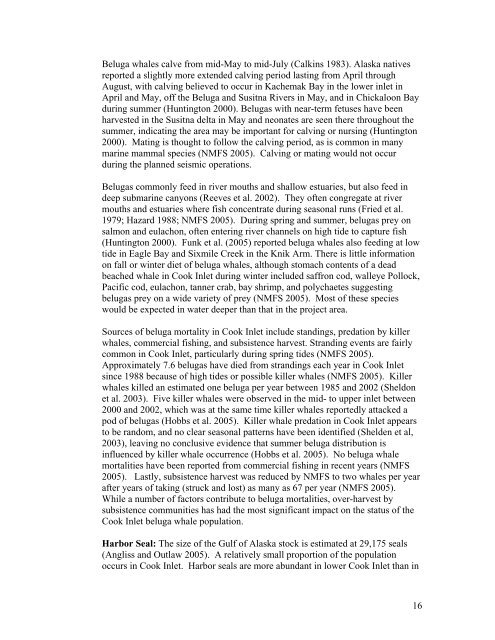IHA Application: Seismic Surveys in Cook Inlet by Marathon Oil ...
IHA Application: Seismic Surveys in Cook Inlet by Marathon Oil ...
IHA Application: Seismic Surveys in Cook Inlet by Marathon Oil ...
You also want an ePaper? Increase the reach of your titles
YUMPU automatically turns print PDFs into web optimized ePapers that Google loves.
Beluga whales calve from mid-May to mid-July (Calk<strong>in</strong>s 1983). Alaska natives<br />
reported a slightly more extended calv<strong>in</strong>g period last<strong>in</strong>g from April through<br />
August, with calv<strong>in</strong>g believed to occur <strong>in</strong> Kachemak Bay <strong>in</strong> the lower <strong>in</strong>let <strong>in</strong><br />
April and May, off the Beluga and Susitna Rivers <strong>in</strong> May, and <strong>in</strong> Chickaloon Bay<br />
dur<strong>in</strong>g summer (Hunt<strong>in</strong>gton 2000). Belugas with near-term fetuses have been<br />
harvested <strong>in</strong> the Susitna delta <strong>in</strong> May and neonates are seen there throughout the<br />
summer, <strong>in</strong>dicat<strong>in</strong>g the area may be important for calv<strong>in</strong>g or nurs<strong>in</strong>g (Hunt<strong>in</strong>gton<br />
2000). Mat<strong>in</strong>g is thought to follow the calv<strong>in</strong>g period, as is common <strong>in</strong> many<br />
mar<strong>in</strong>e mammal species (NMFS 2005). Calv<strong>in</strong>g or mat<strong>in</strong>g would not occur<br />
dur<strong>in</strong>g the planned seismic operations.<br />
Belugas commonly feed <strong>in</strong> river mouths and shallow estuaries, but also feed <strong>in</strong><br />
deep submar<strong>in</strong>e canyons (Reeves et al. 2002). They often congregate at river<br />
mouths and estuaries where fish concentrate dur<strong>in</strong>g seasonal runs (Fried et al.<br />
1979; Hazard 1988; NMFS 2005). Dur<strong>in</strong>g spr<strong>in</strong>g and summer, belugas prey on<br />
salmon and eulachon, often enter<strong>in</strong>g river channels on high tide to capture fish<br />
(Hunt<strong>in</strong>gton 2000). Funk et al. (2005) reported beluga whales also feed<strong>in</strong>g at low<br />
tide <strong>in</strong> Eagle Bay and Sixmile Creek <strong>in</strong> the Knik Arm. There is little <strong>in</strong>formation<br />
on fall or w<strong>in</strong>ter diet of beluga whales, although stomach contents of a dead<br />
beached whale <strong>in</strong> <strong>Cook</strong> <strong>Inlet</strong> dur<strong>in</strong>g w<strong>in</strong>ter <strong>in</strong>cluded saffron cod, walleye Pollock,<br />
Pacific cod, eulachon, tanner crab, bay shrimp, and polychaetes suggest<strong>in</strong>g<br />
belugas prey on a wide variety of prey (NMFS 2005). Most of these species<br />
would be expected <strong>in</strong> water deeper than that <strong>in</strong> the project area.<br />
Sources of beluga mortality <strong>in</strong> <strong>Cook</strong> <strong>Inlet</strong> <strong>in</strong>clude stand<strong>in</strong>gs, predation <strong>by</strong> killer<br />
whales, commercial fish<strong>in</strong>g, and subsistence harvest. Strand<strong>in</strong>g events are fairly<br />
common <strong>in</strong> <strong>Cook</strong> <strong>Inlet</strong>, particularly dur<strong>in</strong>g spr<strong>in</strong>g tides (NMFS 2005).<br />
Approximately 7.6 belugas have died from strand<strong>in</strong>gs each year <strong>in</strong> <strong>Cook</strong> <strong>Inlet</strong><br />
s<strong>in</strong>ce 1988 because of high tides or possible killer whales (NMFS 2005). Killer<br />
whales killed an estimated one beluga per year between 1985 and 2002 (Sheldon<br />
et al. 2003). Five killer whales were observed <strong>in</strong> the mid- to upper <strong>in</strong>let between<br />
2000 and 2002, which was at the same time killer whales reportedly attacked a<br />
pod of belugas (Hobbs et al. 2005). Killer whale predation <strong>in</strong> <strong>Cook</strong> <strong>Inlet</strong> appears<br />
to be random, and no clear seasonal patterns have been identified (Shelden et al,<br />
2003), leav<strong>in</strong>g no conclusive evidence that summer beluga distribution is<br />
<strong>in</strong>fluenced <strong>by</strong> killer whale occurrence (Hobbs et al. 2005). No beluga whale<br />
mortalities have been reported from commercial fish<strong>in</strong>g <strong>in</strong> recent years (NMFS<br />
2005). Lastly, subsistence harvest was reduced <strong>by</strong> NMFS to two whales per year<br />
after years of tak<strong>in</strong>g (struck and lost) as many as 67 per year (NMFS 2005).<br />
While a number of factors contribute to beluga mortalities, over-harvest <strong>by</strong><br />
subsistence communities has had the most significant impact on the status of the<br />
<strong>Cook</strong> <strong>Inlet</strong> beluga whale population.<br />
Harbor Seal: The size of the Gulf of Alaska stock is estimated at 29,175 seals<br />
(Angliss and Outlaw 2005). A relatively small proportion of the population<br />
occurs <strong>in</strong> <strong>Cook</strong> <strong>Inlet</strong>. Harbor seals are more abundant <strong>in</strong> lower <strong>Cook</strong> <strong>Inlet</strong> than <strong>in</strong><br />
16
















